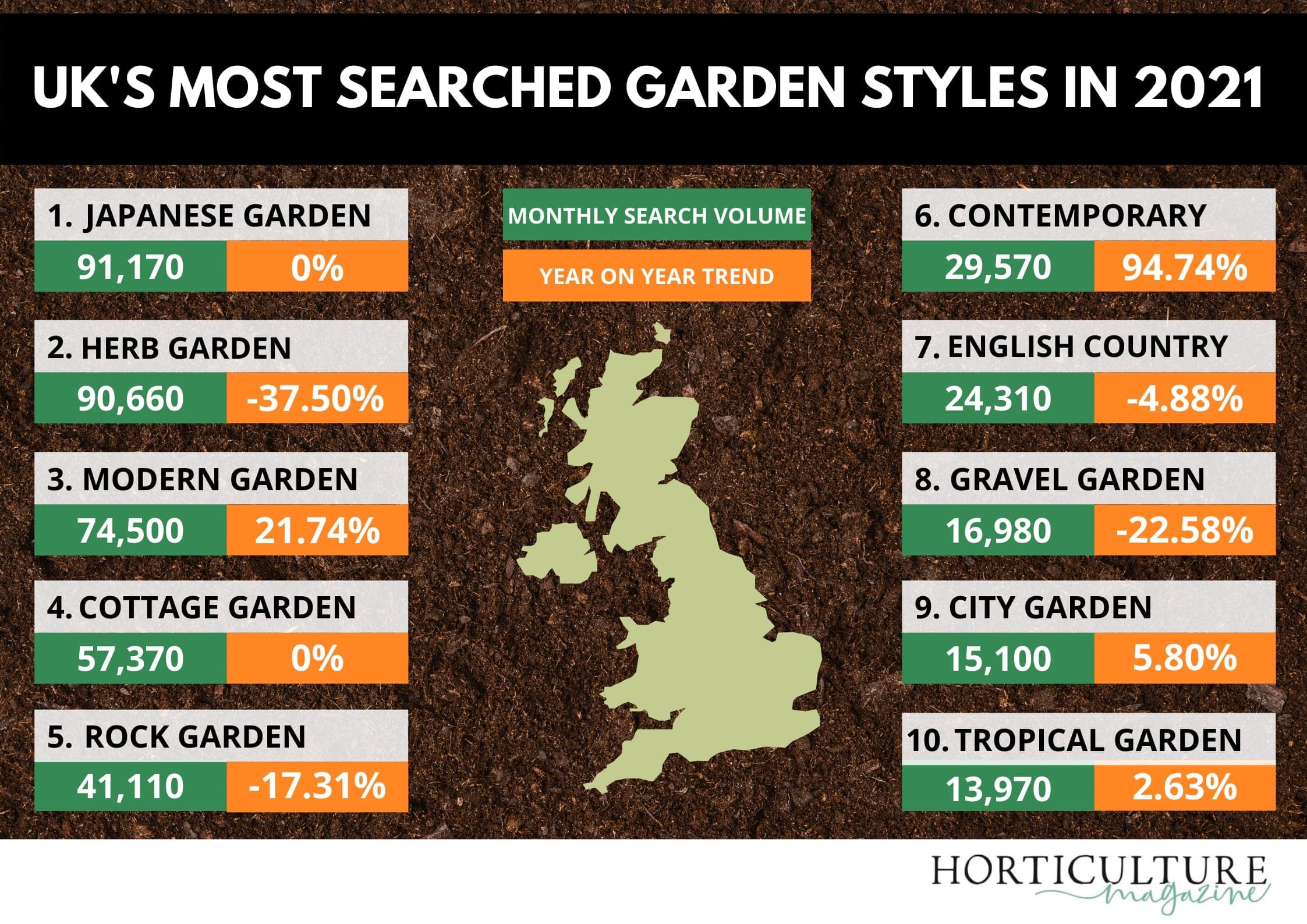Data analysis* from Horticulture.co.uk can reveal that Japanese Gardens are the most-searched-for garden style so far in 2021.
The five most searched-for garden styles are as follows:
- Japanese
- Herb
- Modern
- Cottage
- Rock
The UK-specific Google data shows that thousands of Brits are looking to turn their outdoor gardens into a sanctuary space of calm reflection.
The analysis shows firmly that smaller growing spaces such as herb and balcony gardens have seen declining interest, while more exotic spaces such as Wildlife and Mediterranean gardens are in.
This is good news for the country’s wildlife that will undoubtedly benefit from an increase in garden ponds, insect-friendly spaces and pollinator plants.
Garden Designer Tips For Creating A Japanese Garden
Our PDC-Qualified Garden Designer Elizabeth Waddington shares these tips for creating a Japanese Garden:
Japanese gardens are spaces which evoke a certain philosophy. They were designed to suggest an ancient, far away natural landscape, and to express the fleeting and fragile nature of life. Achieving the feel of a Japanese garden means combining plants and other natural elements to achieve this feel.
Incorporate Traditional Japanese Garden Elements
-
Water features, especially flowing water, waterfalls and koi filled ponds. Stone basins for drinking and washing are also traditional.
-
Incorporate rocks, and perhaps sand/gravel in a zen garden. Water and rock represent yin and yang in a Japanese garden.
-
Add a bridge over a Japanese garden inspired water feature. Bridges were traditionally painted red in Japanese temple gardens. Bridges symbolise the path to immortality.
-
Add bamboo elements such as bamboo fencing, trellises or use bamboo elements in garden water features.
-
Include winding pathways which lead people through a series of miniaturised garden landscapes, revealing new vistas along the journey.
Choose Plants Carefully
Japanese gardens often include trees such as acers, pines, cedar, cypress, ginkgo, and cherries. Bamboos are common, as are acid-loving shrubs like camellias and azaleas.
Nothing in a Japanese garden is left to chance. Each plant is carefully chosen and the plants are arranged to create pleasing vistas at every turn. Add moss on shady rocks for a naturalistic effect.
Shape Plants To Suggest Natural Landscapes and Age
Trees and shrubs in a Japanese garden are not only chosen carefully, they are also often shaped and pruned into artistic shapes to suggest natural landscapes and give the impression of great age.
Constrain trees into bent and contorted forms, and/or undertake cloud pruning and other topiary techniques. Shape trees and shrubs to control the eye, and conceal certain elements from view to create a beautiful effect.
Borrow Landscape From Beyond the Garden Boundaries
Plants within the garden should also ‘speak to’ elements in the broader environment around the space. Views of hills, large trees, or other landscape features outside the garden are blended into the design, to make the garden seem larger than it is in reality.
Create Order, But Avoid Symmetry
Japanese gardens always have a sense of calm and order. But they are not symmetrical. They are not laid out with straight lines along straight axes but have elements of asymmetry and a naturalistic feel.
When thinking about layout, you should also consider including larger rocks and trees in the foreground, and smaller ones in the background, to make the space look bigger and give the sense of a natural landscape made miniature.
Garden Styles Data
* Data for the 20 most-searched garden styles:
| Style | Monthly Search Volumes (Google UK) | Google Trends Year-On-Year Change |
| Japanese Garden | 91,170 | 0.00% |
| Herb Garden | 90,660 | -37.50% |
| Modern Garden | 74,500 | 21.74% |
| Cottage Garden | 57,370 | 0.00% |
| Rock Garden | 41,110 | -17.31% |
| Contemporary Garden | 29,570 | 94.74% |
| English Country Garden | 24,310 | -4.88% |
| Gravel Garden | 16,980 | -22.58% |
| City Garden | 15,100 | 5.80% |
| Tropical Garden | 13,970 | 2.63% |
| Vintage Garden | 12,810 | 5.77% |
| Rustic Garden | 12,360 | -37.84% |
| Mediterranean Garden | 10,150 | 48.48% |
| Urban Garden | 9,790 | -7.55% |
| Container Garden | 7,680 | -37.74% |
| Woodland Garden | 7,510 | -24.00% |
| Balcony Garden | 7,370 | -33.33% |
| Wildlife Garden | 6,510 | 51.52% |
| Moroccan Garden | 5,890 | -17.50% |
| Victorian Garden | 4,610 | 0.00% |
The data used in this report was obtained from ‘Exact Match’ searches in the SEMRush Keyword Magic Tool and Google Trends keyword data.
If you have enjoyed reading our blog post then why not fill in the form provided to allow us to send you our blog posts and newsletters by email.

